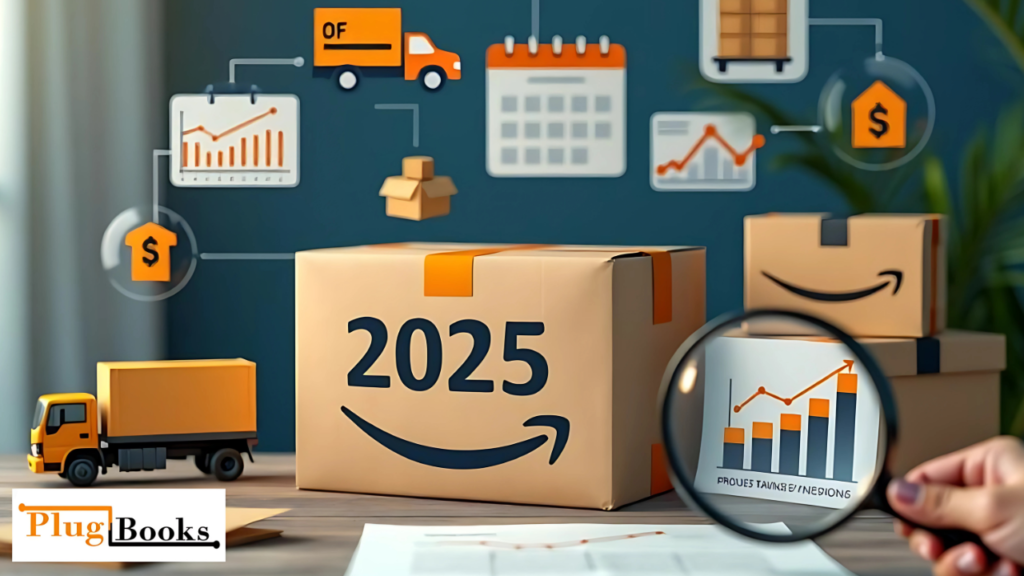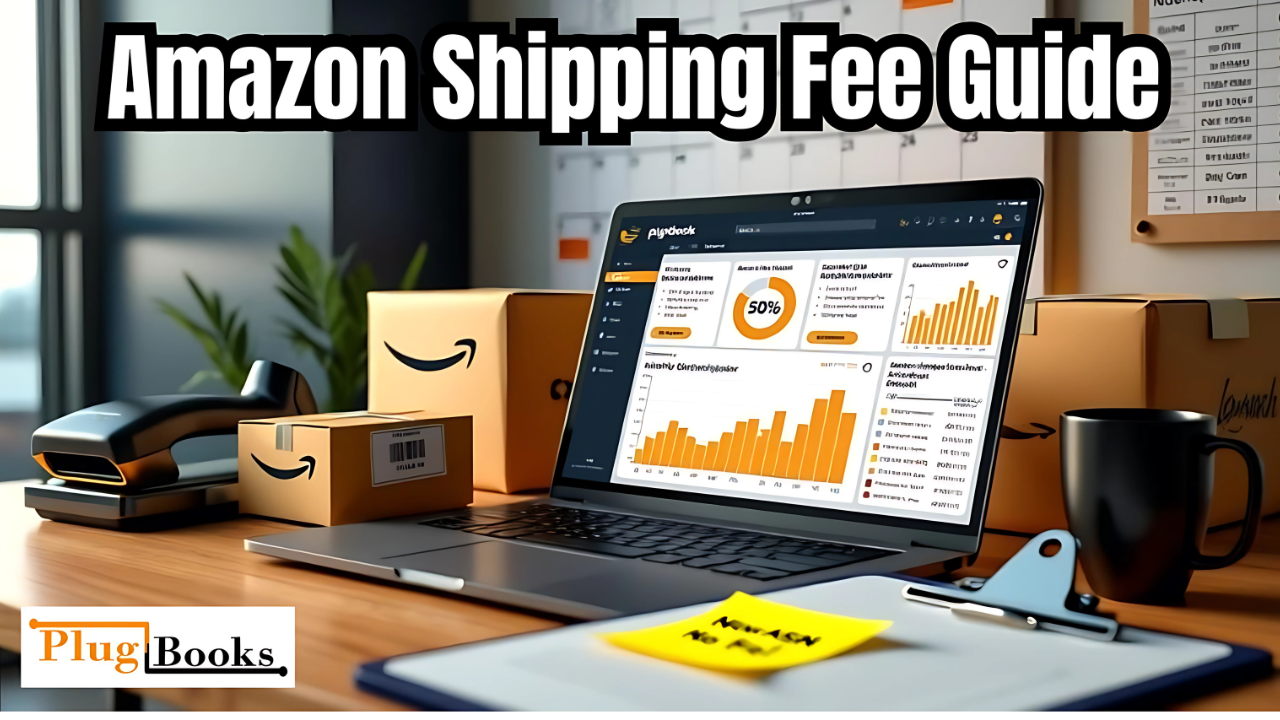Shipping expenses can either make or break the earnings of those who sell goods on Amazon. Given Amazon’s annual changes and wide range of fulfillment options, it might be difficult to grasp how its shipping costs are structured. Whether you use Fulfilment by Amazon (FBA) or Seller Filled Prime (SFP), it’s crucial to understand how the Amazon shipping fee is handled.
To keep competitive, Amazon made some major adjustments in 2025 that all sellers should be aware of. New ASINs will not incur fees, and big item pricing will be lower. These shifts could affect your bottom line. The newest costs are broken out in this book along with advice on how to manage them. Discover also how Plugbooks can simplify tracking shipping costs and working with QuickBooks free from errors.
Keynotes
- Amazon shipping fees vary by fulfillment method, size, and weight.
- Amazon began offering light item cost breaks as well as new ASINs for 2025.
- Shipping fees have been cut in off-peak months.
- Should a product’s quoted size be incorrect, shipping expenses may increase.
- Plugbooks tracks items in real time and connects with QuickBooks to simplify handling expenses.
Understanding the Amazon Shipping Fee Structure
You must know the specifics of the delivery prices if you are to remain competitive and profitable on Amazon in 2025. With Fulfilment by Amazon (FBA) and Seller Fulfilled Prime (SFP) the most often used options Amazon provides for merchants on shipping their products.
Everything has advantages and drawbacks. Whether you’re a new seller seeking to expand an existing shop or simply wanting to control your bottom line, knowing how these Amazon shipping costs operate will help.
Fulfillment by Amazon (FBA) Shipping Fees
Amazon handles everything from shipping and customer service to storage and packing—with FBA. The fees are broken out here:
- Standard-Size Items: Starting in 2025, small, light items pay $3.22 per unit costs.
- Oversize Items: Based on their weight, size, and dimensions, oversize items can run you $150 or more.
- Fuel and Inflation Surcharges: Every three months, surcharges for inflation and gasoline are imposed to adjust for growing transportation and shipping costs.
- Storage Fees: Charged monthly, storage fees are determined by the cubic feet of space your products occupy in Amazon’s facilities.
- Removal & Disposal Fees: Reversing unsold or surplus goods from Amazon delivery hubs results in removal and disposal fees.
Seller Fulfilled Prime (SFP) Shipping Fees
Charges for Seller Fulfilled Prime (SFP) Shipping: You keep the Prime badge and distribute goods straight to consumers using SFP, therefore increasing visibility and trust.
- Carrier Costs: Prices rely on the degree of service and the destination since you choose your own shipping firms.
- Prime Speed Compliance: Prime Speed includes following Amazon’s high-speed delivery requirements—usually 1-2 days.
- Handling Costs: Packaging, marking, and handling returns falls under the seller’s responsibility as well as their expense.
Inbound shipping prices (to transport goods to Amazon or delivery centers), long-term storage expenses, and return processing fees for both FBA and SFP will all count toward your overall Amazon shipping costs.
Choosing the correct model depends on your product size, shipping volume, business running style, and desired level of control. For vendors with poor profit margins or a lot of activity, a thorough awareness of these costs is crucial.

2025 Updates to Amazon Shipping Fees
All sellers should carefully review and be sure Amazon’s proposed 2025 delivery fees reflect certain significant adjustments they make. These adjustments are meant to increase output, inspire fresh ideas, and reduce the execution cost for a greater spectrum of products:
1. Reduced Fees for Apparel & Lightweight Items
Reduced shipping costs for light-weight items and clothing For goods weighing less than two pounds mostly clothes and accessories shipping fees have dropped. Salespeople in these sectors can thereby increase their income.
2. Fee Waivers for New ASINs
For the first thirty days they are on the market, Amazon is currently exempting the shipping costs for newly listed products (ASINs). This is meant to inspire vendors to add fresh products.
3. Updated Dimensional Weight Policies
Using more exact measurements of dimensional weight, which helps to determine shipping costs, changes to dimensional weight policies help to create a pricing system more in line with the sizes of actual packages.
4. Off-Peak Season Discounts
Slower months allow merchants to receive less expensive shipping, therefore reducing the cost of off-season transportation of items.
Important for maintaining competitiveness in the always shifting Amazon environment, these adjustments to 2025 fees are aimed to inspire sellers to operate their companies more effectively and provide a greater spectrum of products.
Common Mistakes Sellers Make with Amazon Shipping Fee
Many Amazon vendors lack sufficient insight on the expense of the Amazon shipping fee. Common hazards include:
- Not incurring moving fees or storage costs
- Errors in packaging quantities
- Not grabbing benefits from shipping fee savings or discounts
Keeping up to current on Amazon’s most recent policies and implementing a robust system to track costs can help one avoid these errors.

How Plugbooks Helps You Track and Optimize Amazon Shipping Fee
Especially if you have a lot of SKUs, utilize both FBA and SFP, and have to deal with constantly changing prices, hand tracking of Amazon’s shipping costs can be challenging. Plugbooks.io quickly syncs your Amazon seller data and classifies all of your costs thereby simplifying this process.
With Plugbooks, you can:
- Plugbooks let you real-time track all Amazon shipping expenses by product, order, or time period.
- Which delivery strategy FBA or SFP makes more money? It’s clear-cut.
- Sort charges automatically and link to your financial program.
Bonus: Plugbooks interacts directly with QuickBooks, so while you’re doing financial reporting you won’t have to hand enter any data. It maintains accuracy, quickness, and cleanliness.
No matter how big or little your Amazon business is, plugbooks ensures you avoid losing money on fees since you cannot view what they are.
Conclusion
Mastering your Amazon shipping fee strategy is no longer optional; it’s a necessity for scaling in 2025. These developments allow sellers options to maximize income since Amazon encourages vendors to maintain things stable and save money. Whether you’re calculating the new SFP charge changes or using FBA, your first focus should be on keeping aware.
By automatically tracking fees, providing a clear view of your shipping expenses, and tying to QuickBooks to simplify reporting, plugbooks and other solutions like them can help you save money. Your shipping data is more under your control the better you run your company. maximize Amazon’s programs and keep expenses under control. Your income depends on smart logistics; today you know how to make them matter.
Disclaimer
The material on this site is exclusively meant for educational purposes. Amazon’s policies on shipping expenses are often changing. See Amazon Seller Central or speak with a financial adviser for the most current data.

FAQs
1. Amazon charges what to ship little, standard-sized products?
Standard FBA policies call for less than one pound, hence the charge in 2025 begins at $3.22.
2. Exist any offers on brand-new products?
Definitely. Amazon does not charge delivery for new ASINs during the first thirty days.
3. How does Amazon ascertain the bodily weight?
Based on the weight and size of the product, Amazon determines the shipping cost; so, it chooses whichever one results in better expenses.
4. Could I find out how much Amazon charges to transport each item?
With a platform like Plugbooks, you can indeed track fees by SKU, product, or time period.
5. Why may you wish to link QuickBooks to Plugbooks?
Syncing fee data directly into your QuickBooks dashboard helps you to simplify bookkeeping.



